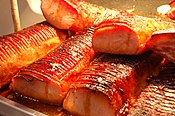
Ham is pork from a leg cut that has been preserved by wet or dry curing, with or without smoking. As a processed meat, the term ham includes both whole cuts of meat and ones that have been mechanically formed.
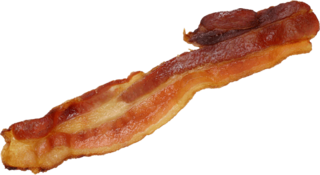
Bacon is a type of salt-cured pork made from various cuts, typically the belly or less fatty parts of the back. It is eaten as a side dish, used as a central ingredient, or as a flavouring or accent. Regular bacon consumption is associated with increased mortality and other health concerns.

A sausage is a type of meat product usually made from ground meat—often pork, beef, or poultry—along with salt, spices and other flavourings. Other ingredients, such as grains or breadcrumbs, may be included as fillers or extenders.

A BLT is a type of sandwich, named for the initials of its primary ingredients, bacon, lettuce, and tomato. It can be made with varying recipes according to personal preference. Simple variants include using different types of lettuce or tomatoes, toasting or not, or adding mayonnaise. More pronounced variants can include using turkey bacon or tofu in place of bacon, removing the lettuce entirely, or adding other ingredients such as a fried egg, avocado, or sprouts.

Braunschweiger is a type of sausage. The type of sausage the term refers to varies by region. In the German language, Braunschweiger is the demonym for people from Brunswick, but under German food law refers to a variety of mettwurst. In Austria, Braunschweiger is known as a type of parboiled sausage (Brühwurst), while American Braunschweiger is often confused with liverwurst.
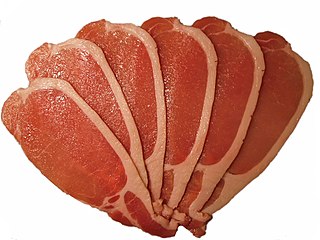
Back bacon is a cut of bacon that includes the pork loin from the back of the pig. It may also include a portion of the pork belly in the same cut. It is much leaner than side bacon made only from the pork belly. Back bacon is derived from the same cut used for pork chops. It is the most common cut of bacon used in British and Irish cuisine, where both smoked and unsmoked varieties of bacon are found.

Pancetta is a salt-cured pork belly meat product in a category known as salume. In Italy, it is often used to add depth to soups and pasta.

A bacon sandwich is a sandwich of cooked bacon. It may be spread with butter, and may be seasoned with brown sauce or tomato ketchup. It is generally served hot. In some establishments the sandwich will be made from bread toasted on only one side, while other establishments serve it on a similar roll as is used for hamburgers.

A fishcake is a culinary dish consisting of filleted fish or other seafood minced or ground, mixed with a starchy ingredient, and fried until golden.
William Davies Company was a pork processing and packing company in Toronto, Ontario, Canada. At one time, it was the largest pork packer in the British Empire, and it operated Canada's first major chain of food stores. One of Toronto's longstanding nicknames, "Hogtown", is attributable to the millions of pigs processed annually by the William Davies Company.
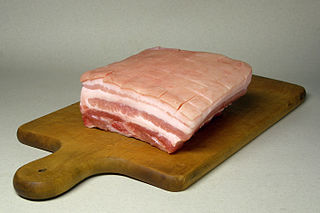
Pork is the culinary name for the meat of the pig. It is the most commonly consumed meat worldwide, with evidence of pig husbandry dating back to 5000 BCE.
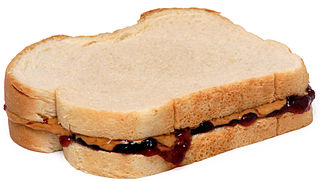
A peanut butter and jelly sandwich (PB&J) consists of peanut butter and fruit preserves spread on bread. The sandwich is popular in the United States, especially among children; a 2002 survey showed the average American will eat 1,500 peanut butter and jelly sandwiches before graduating from high school. There are many variations of the PB&J, which itself is a hybrid between a peanut butter sandwich and a jam sandwich.

Turkey bacon is a meat prepared from chopped, formed, cured, and smoked turkey, commonly marketed as a low-fat alternative to pork bacon; it may also be used as a substitute for bacon where religious dietary laws forbid the consumption of pork products.

A bacon, egg and cheese sandwich (B.E.C.) is a breakfast sandwich popular in the United States and Canada; it is particularly culturally significant in New York City, where it is typically served on a Bulkie roll. It is made with bacon, eggs, cheese and bread, which may be buttered and toasted. Many similar sandwiches exist, substituting alternate meat products for the bacon or using different varieties of cheese or bread.
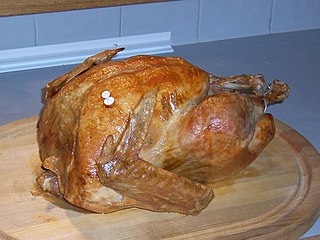
Turkey meat, commonly referred to as just turkey, is the meat from turkeys, typically domesticated turkeys, but also wild turkeys. It is a popular poultry dish, especially in North America and the United Kingdom, where it is traditionally consumed as part of culturally significant events such as Thanksgiving and Christmas respectively, as well as in standard cuisine.

The Bacon Cookbook: More than 150 Recipes from Around the World for Everyone's Favorite Food is a cookbook on bacon by James Villas. It was published by Wiley in 2007. Villas is a former food editor for Town & Country magazine, and The Bacon Cookbook is his 15th book on food. He notes on the book's jacket that he was "beguiled by bacon since he was a boy." He describes the appeal of bacon in the book's preface, and in the introduction recounts the history of the product, as well as its variations from different locations internationally. Chapters are structured by type of recipe and food course, and in total the book includes 168 recipes.

Speck can refer to a number of European cured pork products, typically salted and air-cured and often lightly smoked but not cooked. In Germany, speck is pickled pork fat with or without some meat in it. In the Netherlands and Flanders, in Dutch, spek means bacon. Throughout much of the rest of Europe and parts of the English-speaking culinary world, speck often refers to South Tyrolean speck, a type of Italian smoked ham. The term speck became part of popular parlance only in the eighteenth century and replaced the older term bachen, a cognate of bacon.
